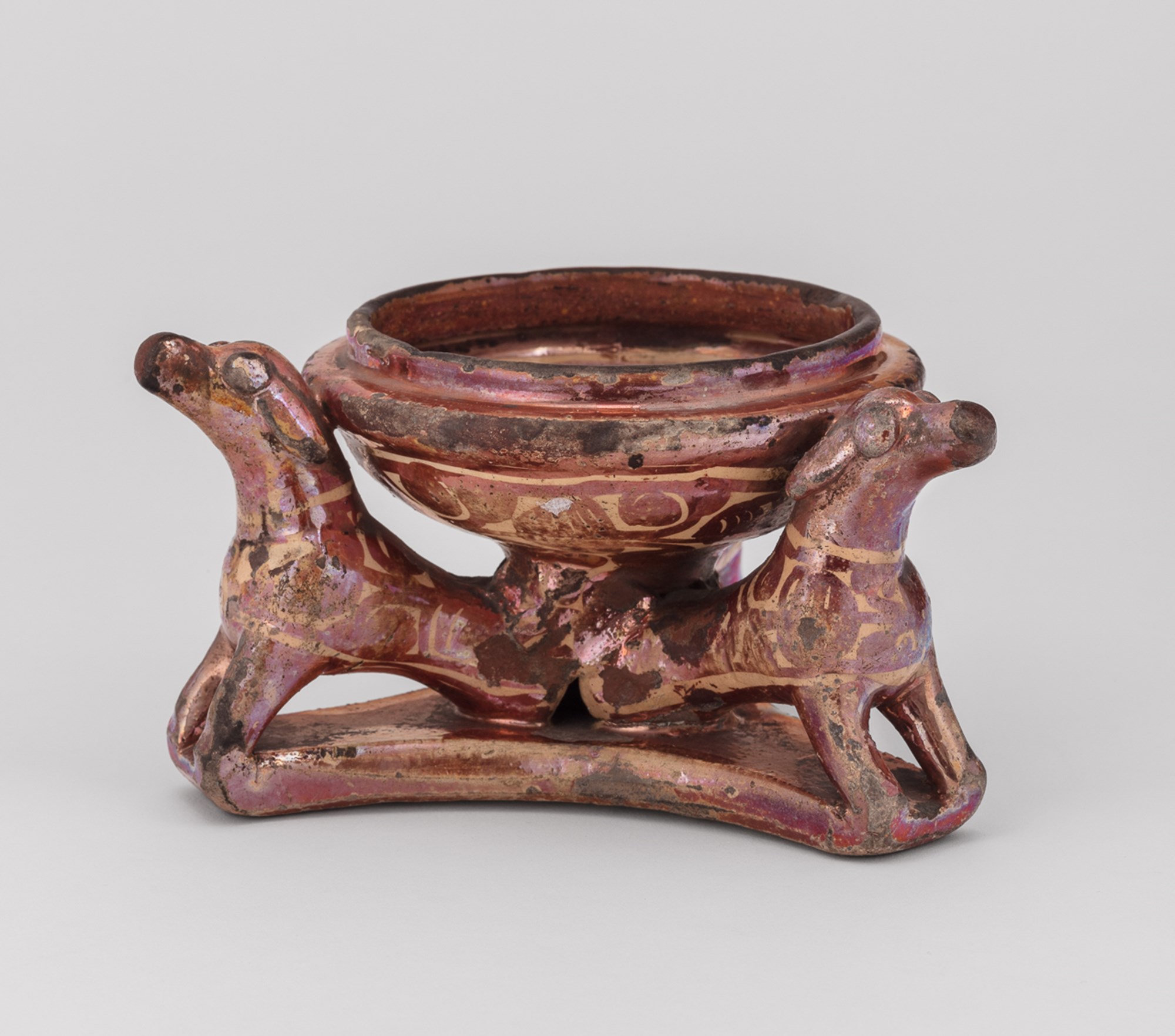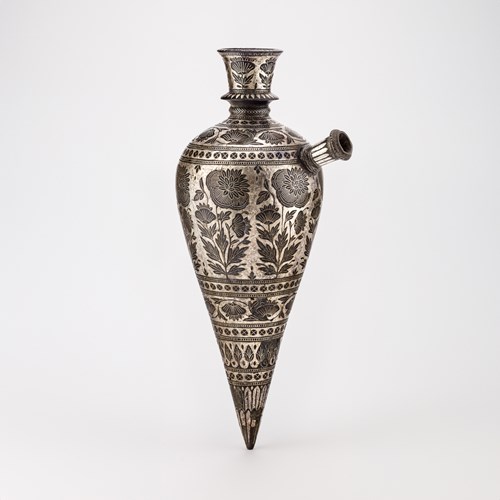Marketplace
Hispano-Moresque Salt Cellar
One of a pair, this cauldron-shaped salt cellar rests on the backs of three dogs, arranged in a triangle, who sit on a y-shaped base. Though rather crudely modelled, with large bulbous eyes and long pointed ears which lay flat against their heads, they are unmistakeably dogs. The origins of this design is contested, but it may come from Italian Renaissance salt cellars, like the one designed by Giulio Romano (see V&A 4900) or from popular metal prototypes manufactured in the Levant.1
This salt cellar is made of tin-glazed fritware, decorated with metallic lustre glaze. Its reddish-brown hue indicates a high copper content, which in turn indicates a later production date. In the 15th and 16th centuries, the heyday of the Valencian ceramics industry, glazes tended towards yellow and gold, indicative of liberal use of silver. As the industry slowed in the 17th and 18th centuries, copper was substituted for silver in the glazes, producing the rich red colour of these pieces.2 The lustre ornamentation is applied in a pattern known as sartas de riñones (lit. strings of kidneys), composed of stylised curled leaves and kidney-shaped flowers, typically seen on honey jars (meleros) produced in Manises from the late 17th century onwards. An example of a melero with this pattern can be viewed in the Victoria & Albert Museum, London (accession no. 1457-1853).
Several comparative examples can be found in French collections; the Louvre (accession no. OA 3207), the Musée des Beaux-Arts, Lyon (accession no. E 500-95), and the Musée National Du Moyen Âge, all dated to the first half of the 18th century from Manises.3 Another is housed in the Museo Nacional de Cerámica, Valencia (accession no. CE1/01692), dated late 17th to early 18th century.
1 Dectot, Xavier. Céramiques hispaniques (XIIe – XVIIIe siècle). Catalogue du Musée National du Moyen Âge. Paris: Éditions de la Réunion des musées nationaux, 2007. Pp. 130.
2 Tolar, Tanja. ‘Spanish Lustre Dish’, Illuminating Objects. Retrieved online at https://sites.courtauld.ac.uk/illuminating-objects/illuminating-objects-home/spanish-lustre-dish/ on 14/05/2024.
3 Dectot, Xavier. Céramiques hispaniques (XIIe – XVIIIe siècle). Catalogue du Musée National du Moyen Âge. Paris: Éditions de la Réunion des musées nationaux, 2007. pp. 130, 131. Cat. 92, 91.
This salt cellar is made of tin-glazed fritware, decorated with metallic lustre glaze. Its reddish-brown hue indicates a high copper content, which in turn indicates a later production date. In the 15th and 16th centuries, the heyday of the Valencian ceramics industry, glazes tended towards yellow and gold, indicative of liberal use of silver. As the industry slowed in the 17th and 18th centuries, copper was substituted for silver in the glazes, producing the rich red colour of these pieces.2 The lustre ornamentation is applied in a pattern known as sartas de riñones (lit. strings of kidneys), composed of stylised curled leaves and kidney-shaped flowers, typically seen on honey jars (meleros) produced in Manises from the late 17th century onwards. An example of a melero with this pattern can be viewed in the Victoria & Albert Museum, London (accession no. 1457-1853).
Several comparative examples can be found in French collections; the Louvre (accession no. OA 3207), the Musée des Beaux-Arts, Lyon (accession no. E 500-95), and the Musée National Du Moyen Âge, all dated to the first half of the 18th century from Manises.3 Another is housed in the Museo Nacional de Cerámica, Valencia (accession no. CE1/01692), dated late 17th to early 18th century.
1 Dectot, Xavier. Céramiques hispaniques (XIIe – XVIIIe siècle). Catalogue du Musée National du Moyen Âge. Paris: Éditions de la Réunion des musées nationaux, 2007. Pp. 130.
2 Tolar, Tanja. ‘Spanish Lustre Dish’, Illuminating Objects. Retrieved online at https://sites.courtauld.ac.uk/illuminating-objects/illuminating-objects-home/spanish-lustre-dish/ on 14/05/2024.
3 Dectot, Xavier. Céramiques hispaniques (XIIe – XVIIIe siècle). Catalogue du Musée National du Moyen Âge. Paris: Éditions de la Réunion des musées nationaux, 2007. pp. 130, 131. Cat. 92, 91.
More artworks from the Gallery







_T638839371737193916.jpg?width=500&height=500&mode=pad&scale=both&qlt=90&format=jpg)
_T638839371969721990.jpg?width=500&height=500&mode=pad&scale=both&qlt=90&format=jpg)
